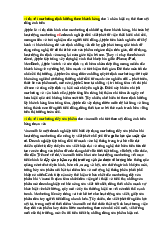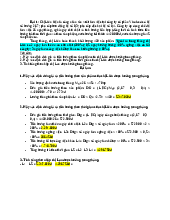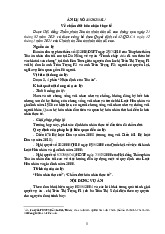











Preview text:
III. Mechanical energy and it’s conservation
• Relationship between force and vector r
• Energy The word energy derives from the Ancient Greek:
ἐνέργεια, romanized: energeia, lit. 'activity, operation’
3 Mechanical energy and it’s conservation (4) • 3.1. Work and power:
• Known: velocity, acceleration, force → new term is work
a scalar product of two vectors F and v Unit : Joule (J)
work is an energy transfer •
3.1.1 Kinetic energy and work-energy theorem Kinetic energy K =
The time rate of doing work is called power.
time rate of energy transfer. average instantaneous power Unit : Watt (W)
Quizz: Suppose that an old truck and a sports car do the same amount of work as
they climb a hill but that the truck takes much longer to accomplish this work. How
would graphs of versus t compare for the two vehicles? Work Done by a Spring
• 3.2 Potential energy of a force field:
• A system, which consists of two or more objects that exert forces on one
another. The space where the force exist is a force field.
• The work done by the field force acting on one of the objects causes a
transformation of energy between the object’s kinetic energy and other forms of the system’s energy.
Conservative forces have two important properties:
1. A force is conservative if the work it does on a particle moving between
any two points is independent of the path taken by the particle.
2. The work done by a conservative force on a particle moving through any
closed path is zero (A closed path is one in which the beginning and end points are identical.)
The work Wc done on an object by a conservative force is equal to the initial
value of the potential energy associated with the object minus the final value.
3.2.1 Gravitational potential energy and theorem of
potential energy in uniform gravitational field
Potential energy for the gravitational force?
3.2.2 Elastic potential energy, potential force field
Elastic potential energy stored in a spring
3.2.3 Conservation of mechanical energy.
If no external forces do work on a system and if no nonconservative forces are acting on
objects inside the system, then the total mechanical energy of the system is constant
3.2.4 Problem-solving strategy using
mechanical energy conservation.
- Define your system. Choose the initial and final points.
• Identify zero points for potential energy (both gravitational and spring). Write an
expression for the potential energy associated with each force.
• Determine whether any nonconservative forces are present. If friction or air
resistance is present, mechanical energy is not conserved.
If mechanical energy is conserved write an expression for the total initial and final
energy. Equate the two total energies.
If mechanical energy is not conserved. The difference between the total final
mechanical energy and the total initial mechanical energy equals the change in
mechanical energy in the system
3.2.5 Relation between force and potential energy in one dimension, in two and three dimensions
3.2.6 Potential energy diagram
If no external forces do work on a system and if no
nonconservative forces are acting on objects inside
the system, then the total mechanical energy of the system is constant •
3,3 Gravitational field: •
3.3.1 Newton’s law of gravitation
Newton suggested that the force of gravity felt by
objects on Earth is the same as the force that holds
planets in their orbits. Consider two massive
objects, m1 and m2, separated by some distance, r, as shown at the right.
Newton's Law of Gravitation
G = 6.6742(10) X 10 - 11 N. m2/kg2
Every particle or matter in the universe attracts every other particle with a
force that is directly proportional to the product or the masses or the particles
and inversely proportional to the square or the distance between them.
3.3.2 Gravitational potential energy r r f f r dr 1 f Mm Mm W = F dr = GMm = GMm − = G − G = (U −U ) c g 2 gi gf r r r r r r r f i i i i
By setting the initial potential energy to zero when the initial position is infinitely far away,
we get the expression for the potential energy due to gravity, Mm U = −G g r
3.3.3 Motion of satellites, satellite orbits a circular orbit escape speed, Exercises an problems •
A ball of mass m is dropped from a height h above the ground. Neglecting air
resistance, determine the speed of the ball when it is at a height y above the ground. •
A skier starts from rest at the top of a frictionless incline of height 20.0 m. At the
bottom of the incline, she encounters a horizontal surface where the coefficient of
kinetic friction between the skis and the snow is 0.210. How far does she travel on
the horizontal surface before coming to rest? •
A block having a mass of 0.80 kg is given an initial velocity v=1.2 m/s to the right and
collides with a spring of negligible mass and force constant k =50 N/m (a) Assuming
the surface to be frictionless, calculate the maximum compression of the spring after
the collision. (b) Suppose a constant force of kinetic friction acts between the block
and the surface, with µ = 0.50. If the speed of the block at the moment it collides with
the spring is v=1.2 m/s, what is the maximum compression in the spring?
• Two blocks are connected by a light string that
passes over a frictionless pulley, as shown in Figure.
The block of mass m1 lies on a horizontal surface
and is connected to a spring of force constant k. The
system is released from rest when the spring is
unstretched. If the hanging block of mass m2 falls a
distance h before coming to rest, calculate the
coefficient of kinetic friction between the block of
mass m1 and the surface.




